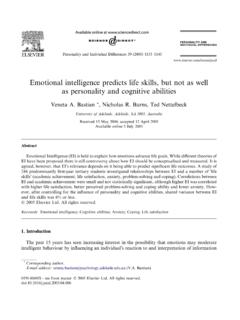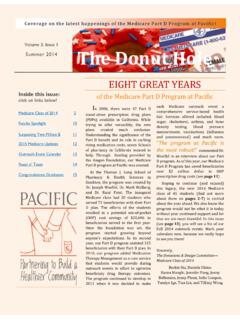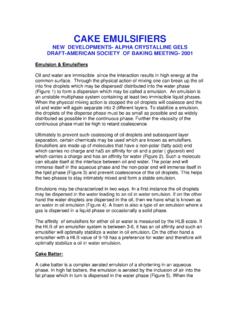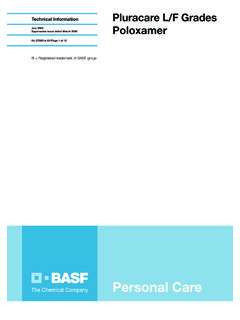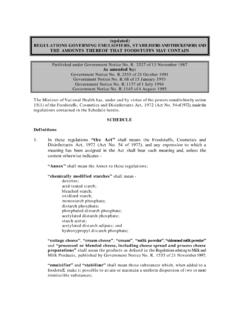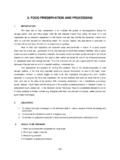Transcription of Baking 101 - University of the Pacific
1 1 1 Bake: Cook in an oven using dry heat. Bakers dozen: For bakers, a dozen of an item means 13 pieces. Caramelized sugar or caramelize: To heat and melt sugar in a sauce pan until the sug-ar turns brown and is ready to be drizzled on pastries or other baked goods. Dough: A mixture of ingredients like butter, sugar and eggs. This is the base of many baked desserts like cookies, breads and cakes . Frost: Put on icing. Glaze: Coating or brushing food with eggs, milk and sometimes sugar before the Baking process. Grease a pan: Brush some oil or butter onto the Baking pan to prevent baked goods from sticking. This is also done so you will have a perfect cookie or cake without forcing it off the Baking tray.
2 Pre-heat an oven: Turn on and heat up the oven 10-15 minutes before use in order to equalize the temperature. Baking 101 2 Kneading bread: Kneading develops long strands of proteins, also called gluten. When the yeast is combined with liquid, it comes to life, starts eating the dough's starches, reproduces, and causes the bread to rise. Both too little kneading or too much yeast will cause the bread to fall during Baking . Pastry flour in cakes and cookies: For a tender crust and interior crumb, many bakers use pastry flour, which is low in protein. Raw, clean eggs in meringues: When you beat raw egg whites to make a souffl or a meringue, you incorporate air bubbles into the water-protein solution.
3 Adding air bubbles to egg whites unfolds egg proteins just like heating them. When an egg protein is up against an air bubble, part of that protein is exposed to air and part is still in water. The protein uncurls so that its water-loving parts can be immersed in the water and its water-fearing parts can stick in the air. Once the proteins uncurl, they bond with each other creating a network that can hold the air bubbles in place. Baking 101 3 Baking powder and Baking soda: Both Baking powder and Baking soda are chemical leavening agents that cause batters to rise when baked. The leavener enlarges the bub-bles which are already present in the batter produced through creaming of ingredients.
4 When a recipe contains Baking powder and Baking soda, the Baking powder does most of the leavening. The Baking soda is added to neutralize the acids in the recipe plus to add tenderness and some leavening. When using Baking powder or Baking soda in a recipe, make sure to sift or whisk with the other dry ingredients before adding to the batter to ensure uniformity. Otherwise the baked good can have large holes. Too much Baking powder can cause the batter to be bitter tasting. It can also cause the batter to rise rapidly and then collapse. Baking soda has an indefinite shelf life if stored in a sealed container in a cool dry place. Too much Baking soda will result in a soapy taste with a coarse, open crumb.
5 Baking soda, also known as sodium bicarbonate or bicarbonate of soda (alkali) is about four times as strong as Baking powder. It is used in recipes that contain an acidic ingredient ( vinegar, citrus juice, sour cream, yogurt, buttermilk, chocolate, cocoa (not Dutch-processed), honey, molasses (also brown sugar), fruits and maple syrup). Baking soda starts to react and release carbon dioxide gas as soon as it is added to the batter and moistened. Make sure to bake the batter immediately. Baking 101 4 Eggs: Eggs have two parts, whites and yolks, which do two different things. Whites are an incredible leavening agent, and yolks are nature's great emulsifiers for creamy texture. Sugar: Sugar prevents the flour proteins from joining and making gluten; gluten development would make a cake or cookie tough.
6 In this way sugar acts as a tenderizer and can replace some of the fat in the recipe. When sugar is present in amounts above 2 tablespoons per cup of flour, the two proteins in flour that normally join with each other and water to form gluten join with the sugar instead. Sugar also caramelizes in Baking , which enriches flavors. Substituting as little as a tablespoon of corn syrup for sugar can make cookies much browner, because corn syrup browns at a lower temperature than sugar. Some sugars, like honey and brown sugar, absorb moisture from the atmosphere, which means that things baked with them will stay soft and moist longer. Don t use sugar substitutes: Sugar is a key ingredient in Baking , providing structure and mass in many desserts.
7 Consider a cake: If you substituted artificial sweetener for sugar, you would lose the volume that sugar contributes, and the cake batter would not have enough substance to become a cake. Also, the tastes and textures of sugar substi-tutes may change when they're heated. Baking 101 5 Why do we use butter: Cookies made with butter spread during Baking , which means they're thinner. Trimming the amount of fat just a little will limit their spread. If you want to reduce the amount of butter but preserve the crispness, add a little corn syrup to the cookie dough. Butter has three roles in cakes : to make the cake light and delicate by holding air bubbles produced by leaveners like Baking powder or soda; to make the cake tender by coating the flour protein; and to carry rich flavors.
8 Stick margarine and shortening can substitute for butter; in fact, shortening is already aerated before you buy it, so it can produce a fine, tender cake. Cream Butter: For air bubbles during Baking it is important to cream the butter/ shortening and sugar together properly to create air bubbles that will expand during Baking . Baking 101 6 Butter (one tablespoon) = One tablespoon polyunsaturated margarine or 3/4 tablespoon polyunsaturated oil like safflower oil Butter = Canola, mild olive oil, prune pur e or applesauce Chocolate (1 ounce) = 3 tablespoons cocoa Cream, whole milk (in batters, muffins or biscuit dough) = Skim or low-fat (1%) milk Cream Cheese (in cheesecake) = Low-fat ricotta + yogurt; light cream cheese Cream cheese = Four tablespoons margarine blended with one cup dry low-fat cottage cheese.
9 Add a small amount of fat-free milk if needed Eggs (2) = 1 egg + 2 whites or egg substitute Heavy cream (one cup) = One cup evaporated skim milk, or one cup half and half Ricotta cheese, whole-milk = 1/2 whole milk ricotta plus either part-skim ricotta or low-fat (1%) cottage cheese Shortening (one cup) = Two sticks polyunsaturated margarine like original Earth Balance or Smart Balance Healthy Substitutes 7 Sour cream = Low-fat Greek yogurt Sour Cream = Plain yogurt Unsweetened Baking chocolate (one ounce) = Three tablespoons unsweetened cocoa powder or carob powder plus one tablespoon polyunsaturated oil (like safflower or corn oil) or margarine. Carob is sweeter than cocoa, so reduce sugar in recipe by Whipped cream, ice cream (to top cakes , pies, warm fruit desserts) = Frozen yogurt, Low-fat yogurt Whipped cream 1 cup (in mousse mixtures) = 3 stiffly beaten egg whites or 3/4 to 1 cup Yogurt Cheese Whipping cream 1 cup = 1 cup evaporated skim milk cream (for whipping) Whole milk (one cup) = One cup fat-free or nonfat milk plus one tablespoon of unsaturated oil like safflower or canola Healthy Substitutes 8 (Revised) From Joyce McCallister, Records Coordinator, Pharmacy Practice Experience Makes 1 standard loaf Ingredients.
10 Cup honey cup no-transfat shortening, like Spectrum or Earth Balance 1 egg cup milk (can use almond or rice) 1 rounded Tablespoon Baking powder 1 teaspoon salt 1 teaspoon vanilla extract 3 cups whole wheat pastry flour 3-5 real ripe bananas, slightly squashed, or cut up in pieces 1 cup chopped nuts Directions: Measure dry ingredients onto a piece of waxed paper or into a bowl and mix with a fork. Blend honey and shortening until creamy in a large mixing bowl (or you can use a stand mixer with the paddle attach-ment). Add milk and egg and mix well, then add dry ingredients and bananas until everything is gently mixed together. Fold in nuts. Pour mixture into a greased loaf pan and let stand 20 minutes.
